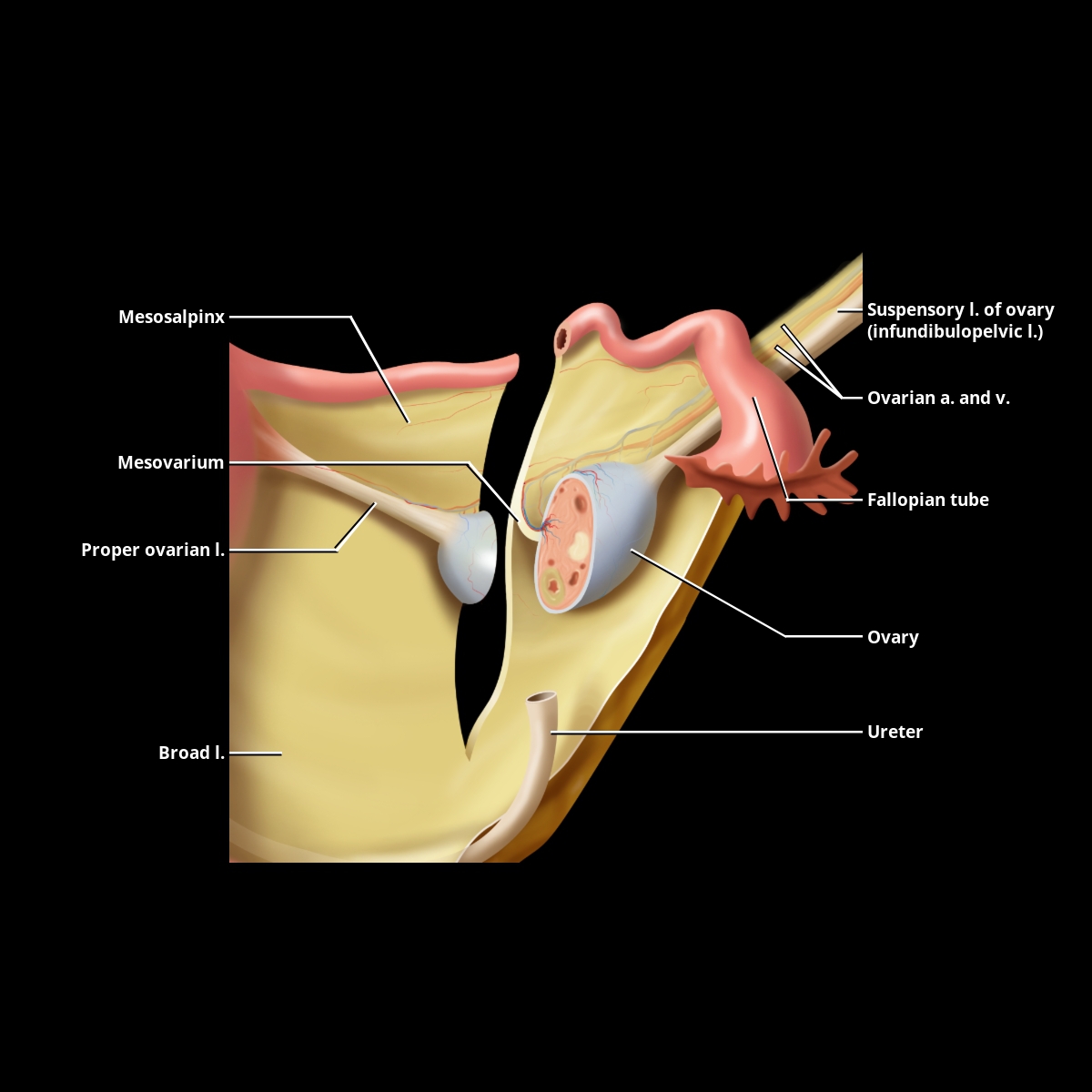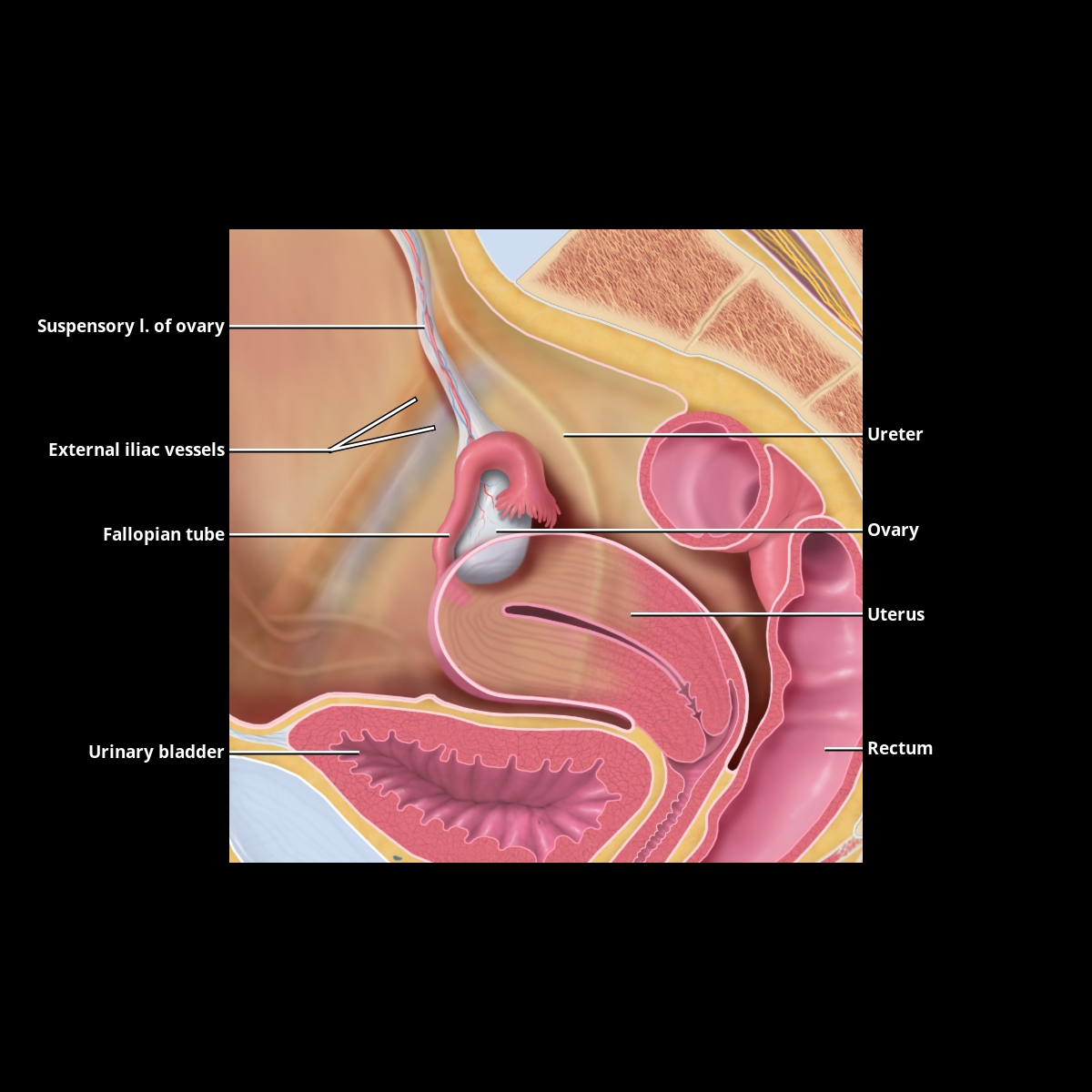GROSS ANATOMY
Overview
- •
Ovaries located in true pelvis, although exact position variable
- ○
Only pelvic organ entirely inside peritoneal sac
- ○
Laxity in ligaments allows some mobility
- ○
Location affected by parity, bladder filling, ovarian size, and uterine size/position
- ○
Located within ovarian fossa in nulliparous women
- –
Lateral pelvic sidewall below bifurcation of common iliac vessels
- –
Anterior to ureter
- –
Posterior to broad ligament
- –
- ○
Position more variable in parous women
- –
Pregnancy displaces ovaries, seldom return to same spot
- –
- ○
- •
Fallopian tube drapes over much of surface
- ○
Partially covered by fimbriated end
- ○
- •
Composed of medulla and cortex
- ○
Vessels enter and exit ovary through medulla
- ○
Cortex contains follicles in varying stages of development
- ○
Surface covered by specialized peritoneum called germinal epithelium
- ○
- •
Ligamentous supports
- ○
Suspensory ligament of ovary (infundibulopelvic ligament)
- –
Attaches ovary to lateral pelvic wall
- –
Contains ovarian vessels and lymphatics
- –
Positions ovary in craniocaudal orientation
- –
- ○
Mesovarium
- –
Attaches ovary to broad ligament (posterior)
- –
Transmits nerves and vessels to ovary
- –
- ○
Proper ovarian ligament (uteroovarian ligament)
- –
Continuation of round ligament
- –
Fibromuscular band extending from ovary to uterine cornu
- –
- ○
Mesosalpinx
- –
Extends between fallopian tube and proper ovarian ligament
- –
- ○
Broad ligament
- –
Below proper ovarian ligament
- –
- ○
- •
Arterial supply: Dual blood supply
- ○
Ovarian artery is branch of aorta, arises at L1/L2 level
- –
Descends to pelvis and enters suspensory ligament
- –
Continues through mesovarium to ovarian hilum
- –
Anastomoses with uterine artery
- –
- ○
Both arteries and veins markedly enlarge in pregnancy
- ○
- •
Drainage via pampiniform plexus into ovarian veins
- ○
Right ovarian vein drains to inferior vena cava
- ○
Left ovarian vein drains to left renal vein
- ○
- •
Lymphatic drainage follows venous drainage to preaortic lymph nodes at L1 and L2 levels
Physiology
- •
~ 400,000 follicles present at birth, but only 0.1% (400) mature to ovulation
- •
Variations in menstrual cycle
- ○
Follicular phase (days 0-14)
- –
Several follicles begin to develop
- –
By days 8-12, dominant follicle develops, while remainder start to regress
- –
- ○
Ovulation (day 14)
- –
Dominant follicle, typically 2.0-2.5 cm, ruptures and releases ovum
- –
- ○
Luteal phase (days 14-28)
- –
Luteinizing hormone induces formation of corpus luteum from ruptured follicle
- –
If fertilization occurs, corpus luteum maintains and enlarges to corpus luteum cyst of pregnancy
- –
- ○
Variations With Age
- •
At birth: Large ovaries ± follicles due to influence of maternal hormones
- •
Childhood: Volume < 1 cm³, follicles < 2-mm diameter
- •
Above 8 year old: ≥ 6 follicles of > 4-mm diameter
- •
Adult, reproductive age: Mean volume: ~ 10 ± 6 cm³; max: 22 cm³
- •
Postmenopausal: Mean: ~ 2-6 cm³; max: 8 cm³ and may contain few follicle-like structures
IMAGING ANATOMY
US
- •
Scan between uterus and pelvic sidewall
- ○
Ovaries often seen adjacent to internal iliac vessels
- ○
- •
Relatively hypoechoic, scattered coarse pattern compared to uterine myometrium
- •
Medulla mildly hyperechoic compared to hypoechoic cortex
- •
Developing follicles anechoic
- •
Dominant follicle around time of ovulation
- ○
Cumulus oophorus: Nodule or cyst along margin of dominant follicle represents mature ovum
- ○
- •
Corpus luteum may have thick, echogenic ring
- ○
Doppler: Vascular wall or “ring”
- ○
Hemorrhage common
- –
Variable appearance: Lace-like septations; fluid-fluid level; retracting clot; internal debris
- –
- ○
- •
Echogenic foci common
- ○
Nonshadowing, 1-3 mm
- ○
Represent specular reflectors from walls of tiny unresolved cysts or small vessels in medulla
- ○
More common in periphery
- ○
- •
Focal calcification may also be seen
- •
Doppler: Low-velocity, low-resistance arterial waveform
- •
Volume (0.523 x length x width x height) more accurate than individual measurements
ANATOMY IMAGING ISSUES
Imaging Recommendations
- •
Transabdominal (TA) US with full bladder is good for overview of pelvic organs
- ○
Detects ovaries and masses superior or lateral to uterus that may be missed by transvaginal (TV) US
- ○
- •
TVUS is excellent in assessing detail of ovaries and characterizing lesions compared to TAUS
- ○
Lesions higher in pelvis can be missed because of limited field of view
- ○
TVUS should be performed with empty bladder
- ○
- •
Piriformis muscle or exophytic fibroids may mimic ovary
- •
Knowledge of last menstrual period is useful for not mistaking normal physiology for pathology
- •
Postmenopausal ovaries can be difficult to detect because of atrophy, paucity of follicles, and surrounding bowel
LIGAMENTOUS SUPPORT AND ANATOMY OF OVARY



Stay updated, free articles. Join our Telegram channel

Full access? Get Clinical Tree








